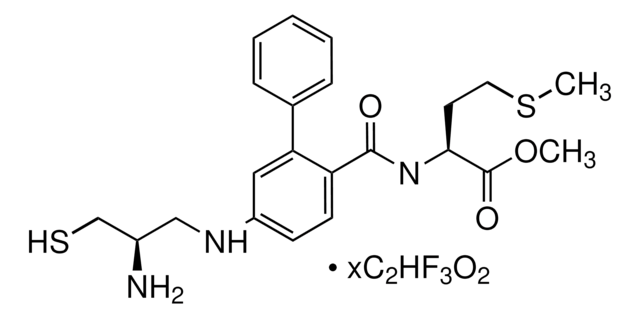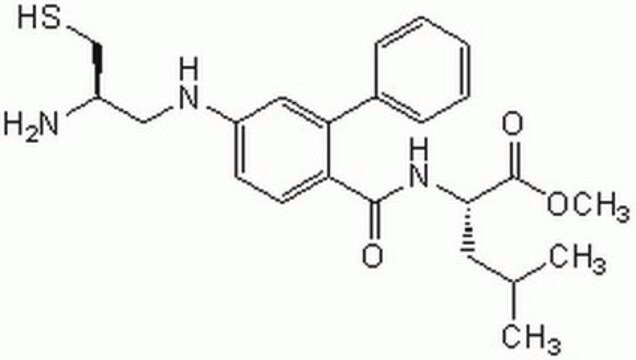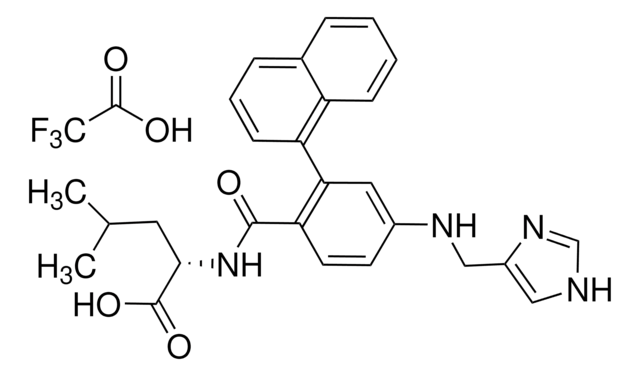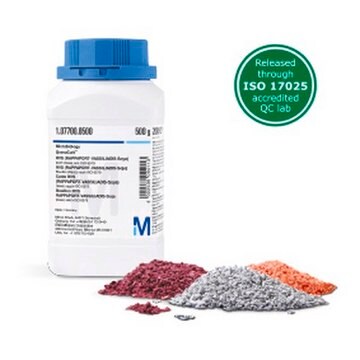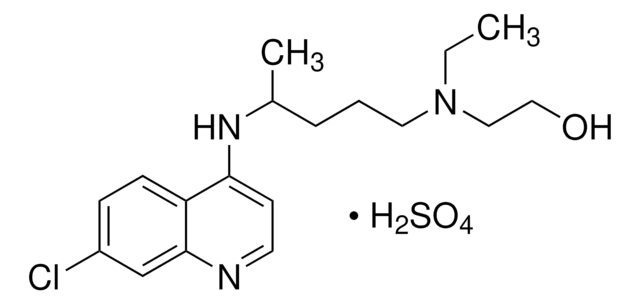G5169
GGTI 298 trifluoroacetate salt hydrate
≥90% (HPLC), film
Sinonimo/i:
N-[[4-(2-(R)-Amino-3-mercaptopropyl)amino]-2-naphthylbenzoyl]leucine methyl ester trifluoroacetate salt hydrate
About This Item
Prodotti consigliati
Livello qualitativo
Saggio
≥90% (HPLC)
Forma fisica
film
lyophilized
Impurezze
<10% dimer
Colore
colorless
Punto di fusione
99.5-100 °C
Solubilità
DMSO: >20 mg/mL
Temperatura di conservazione
−20°C
Stringa SMILE
OC(=O)C(F)(F)F.COC(=O)[C@H](CC(C)C)NC(=O)c1ccc(NC[C@@H](N)CS)cc1-c2cccc3ccccc23
InChI
1S/C27H33N3O3S.C2HF3O2/c1-17(2)13-25(27(32)33-3)30-26(31)23-12-11-20(29-15-19(28)16-34)14-24(23)22-10-6-8-18-7-4-5-9-21(18)22;3-2(4,5)1(6)7/h4-12,14,17,19,25,29,34H,13,15-16,28H2,1-3H3,(H,30,31);(H,6,7)/t19-,25+;/m1./s1
WALKWJPZELDSKT-UFABNHQSSA-N
Informazioni sul gene
human ... PGGT1B(5229)
Applicazioni
- to study the anticancer effects of statins along with GGTI 298
- to study its combinatorial effects with FTI-277 on statin-mediated activation of extracellular signal-regulated kinase 5 (ERK5) in the human endothelium
- to evaluate the effect of protein geranylgeranylation (GG) inhibition on the breast cancer stem cell (CSC) population
Azioni biochim/fisiol
Caratteristiche e vantaggi
Avvertenze
Warning
Indicazioni di pericolo
Consigli di prudenza
Classi di pericolo
Eye Irrit. 2 - Skin Irrit. 2 - STOT SE 3
Organi bersaglio
Respiratory system
Codice della classe di stoccaggio
11 - Combustible Solids
Classe di pericolosità dell'acqua (WGK)
WGK 3
Punto d’infiammabilità (°F)
Not applicable
Punto d’infiammabilità (°C)
Not applicable
Dispositivi di protezione individuale
dust mask type N95 (US), Eyeshields, Gloves
Certificati d'analisi (COA)
Cerca il Certificati d'analisi (COA) digitando il numero di lotto/batch corrispondente. I numeri di lotto o di batch sono stampati sull'etichetta dei prodotti dopo la parola ‘Lotto’ o ‘Batch’.
Possiedi già questo prodotto?
I documenti relativi ai prodotti acquistati recentemente sono disponibili nell’Archivio dei documenti.
Il team dei nostri ricercatori vanta grande esperienza in tutte le aree della ricerca quali Life Science, scienza dei materiali, sintesi chimica, cromatografia, discipline analitiche, ecc..
Contatta l'Assistenza Tecnica.